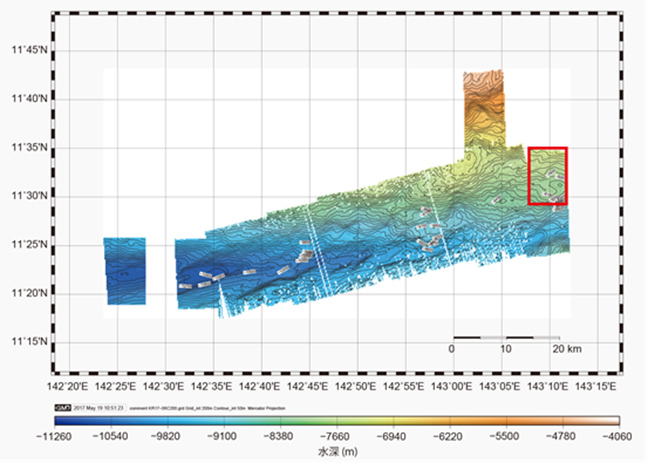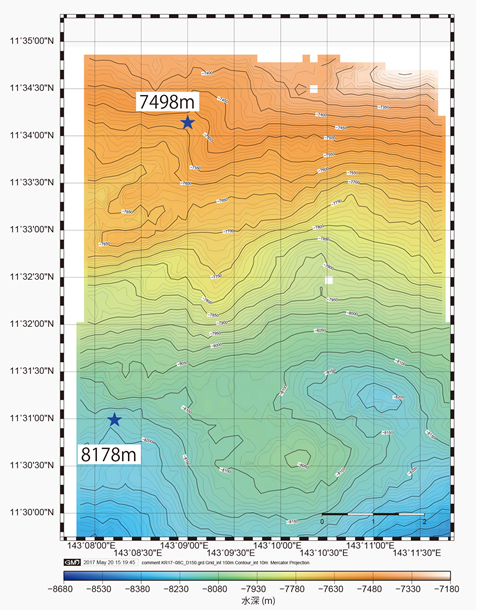Press Releases
JAMSTEC
Deepest Fish Ever Recorded —
Documented at Depths of 8,178 m in Mariana Trench
A snailfish* was filmed in the Mariana Trench at depths of 8,178 m, exceeding the past record of 8,152 m by 26 m. The depth was determined by conductivity, temperature and pressure (CTD) sensor installed on a lander. This research cruise was carried out in collaboration with the Japan Agency for Marine-Earth Science and Technology (JAMSTEC) and the Japan Broadcasting Corporation (NHK) in May 2017.
Video footage of the deepest recorded fish will be presented at a special exhibition — DEEP OCEAN — at the National Museum of Nature and Science in Tokyo from August 28, 2017
During a research cruise by JAMSTEC’s research vessel Kairei, a newly designed compact hadal-lander with 4K video cameras installed was placed at depths of 7,498 m and 8,178 m in the Mariana Trench. To attract deep-sea organisms, mackerel was placed in front of the lander frame。At both depths, many dark-colored stones were distributed on the muddy sea floor. At both sites, the first organisms that appeared were amphipods. They fed on the mackerel and consumed them in a few hours. At 7,498 m, a species of snailfish first appeared 3 hours and 37 minutes after the lander was placed on the sea floor. Throughout the period of observation, the snailfish population increased. A giant amphipod was also observed on the video recorded at this depth.
At 8,178 m, a swimming snailfish was captured on the video. It appeared 17 hours and 37 minutes after lander placement. Based on its shape, this snailfish seems to be the same species observed at the 7,498 m site. The snailfish was seen again after its first appearance, though the population did not increase.
Deep-sea organisms and their ecosystems have attracted great scientific interest; however, extremely high pressure in deep-sea trenches has prevented sampling as well as video recordings. The research team will continue investigations of hadal organisms, attempting to collect samples for analyses to better understand the population density of the organisms and the food chain at water depths below 8,000 m.
* In 2014, two species of snailfish, the ‘Mariana snailfish’ (6,198–8,076 m) and the ‘Ethereal snailfish’ (7,939–8,145 m) were discovered in the Mariana Trench by the U.K and U.S study group. The snailfish found during this cruise is considered to be a type of the ‘Mariana snailfish’.
(Linley, T. D., Gerringer, M. E., Yancey, P. H., Drazen, J. C., Weinstock, C. L., Jamieson, A. J. (2016) Fishes of the hadal zone including new species, in situ observations and depth records of Liparidae, Deep Sea Research I, 114, 99–110.)

Figure 1A. Bathymetric map of the Mariana Trench.

Figure 1B: Detailed map from red square in Fig. 1A. Two lander deployment sites are shown as blue stars,

Figure 2. Compact hadal-lander, all parts used are designed to be used below 10,000 m
A: Front view, (1) Flasher; (2) Syntactic form; (3) Acoustic transducer; (4) Emergency timer for weight release; (5) Glass sphere and its plastic cover; (6) LED illuminations; (7) 4K cameras; (9) Weight release device; (10) mackerel bait; and (11) Weight
B: Rear view, (12) CTD sensor

Figure 3. Organisms recorded at 7,498 m
A: First, amphipods appeared around the mackerels. Then, snailfish appeared.
B: Giant amphipod and snailfish.

Figure 4. Deepest fish recorded at 8,178 m
A: Snailfish swimming.
B: Snailfish resting on the sea floor.
Deepest Fish Ever Recorded — Documented at Depths of 8,178 m in Mariana Trench
This research cruise was conducted under a Special Use Permit (#12541-17001) issued by the Mariana Trench National Wildlife Refuge, U.S. Fish and Wildlife Service, Department of the Interior.
Contacts:
- JAMSTEC
- (For organisms and lander technology)
- Kazumasa Oguri, Senior Research Scientist, Department of Marine Biodiversity Research (BIO-DIVE)
- (For press release)
- Tsuyoshi Noguchi, Manager, Press Division, Public Relations Department